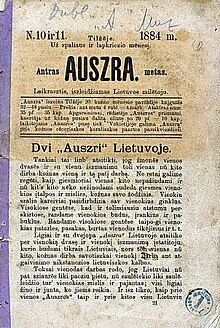Aušra

AušraorAuszra(literally:dawn) was the first nationalLithuaniannewspaper. The first issue was published in 1883, inRagnit,East Prussia,Germany(newspaper credited it asLithuanian:Ragainė) East Prussia's ethnolinguistic part -Lithuania Minor.Later it was published monthly in Tilsit (present-daySovetsk). Even though only forty issues were published and the circulation did not exceed 1,000, it was a significant event as it marked the beginnings of theLithuanian national rebirththat eventually resulted in an independent Lithuanian State (1918–1940). This period, between 1883 and 1904, when theLithuanian press banwas enforced by Tsarist authorities, has been referred to as theAušros gadynė(the Dawn Period). The printing ceased in 1886 as a result of financial issues.
History
[edit]After the Russian authorities denied permission to publish a Lithuanian newspaper inVilnius,Jonas Šliūpasproposed to publish it inEast Prussia,Germany.However, he was perceived as too radical, and Jurgis Mikšas, the printer, invitedJonas Basanavičiusto become its first editor. During its three years of existence,Aušrahad a total of five editors. After Mikšas had to resign for personal reasons, Šliūpas was entrusted to oversee future publications. However, he ran into conflicts with Basanavičius, who was living inBulgaria.Šliūpas also had issues with the German authorities due to his involvement in nationalistic movements and had to leave Prussia in 1884. The other editors,Martynas Jankusand Jonas Andziulaitis, did not engage in polemic writing and the controversies calmed down. Soon Mikšas ran into debt and could no longer support the newspaper. The printing was discontinued.
AfterAušrawas discontinued, new Lithuanian-language periodicals appeared.Varpas(literally:The Bell) was a secular newspaper, whileŠviesawas more conservative and was a religiously oriented publication.
The newspaper was published outside Lithuania proper because of theLithuanian press banthat had been enforced by the authorities of theRussian Empiresince theUprising in 1863.It was prohibited to publish anything in theLithuanian languageusing theLatin Alpha bet;the government wished to force the people to useGrazhdanka,aCyrillic Alpha bet.Printing in the Latin Alpha bet was organized abroad, mostly in Lithuania Minor;knygnešiai(literally:book smugglers) would carry the printed materials across the German-Russian border. This was one of the waysAušrawould reach its readers. The other way was in sealed envelopes.
Content
[edit]More than 70 people contributed toAušra.The writers, orAušrininkai,came from families of well-to-do peasants that started to appear afterserfdomwas abolished in 1863. Most of the authors received education in the Russian universities and were fluent in Polish. Because of frequent changes in editorial staff, the newspaper did not have a clear and well-defined agenda. Basanavičius did not envisionAušraas a political publication; in the first issue he declared that the newspaper would deal only with cultural matters. However,Aušrasoon took on a nationalistic agenda.Aušrahelped to crystallize many ideas about the Lithuanian nation and the definition of a Lithuanian. It started to reject the ideas of resurrecting the oldPolish–Lithuanian Commonwealth.The authors started to think about an independent Lithuanian nation-state.
It published on many different subjects like agriculture or reports from Lithuanian communities in theUnited States,but history was the most popular. The foreword of the first issue began with a Latinproverb,Homines historiarum ignari semper sunt pueri,orPeople ignoring history remain children forever.They built upon the works ofSimonas Daukantas,the first historian, who wrote history of Lithuania inLithuanianand painted an idealized image of the mightyGrand Duchy of Lithuania.Aušrawas critical regarding the forceful Polonisation executed by the Polish clergy and Tsarist Russification. One of the main aims ofAušraeditors was to gain the usage rights to Lithuanian language and to revive its prestige.
The newspaper was directed at the intelligentsia and therefore limited its readership. The peasants did not appreciate thatAušrawas secular and did not embrace Catholic traditions.
References
[edit]- Krapauskas, Virgil (2000). "The Historiography ofAuszraand theAušrininkai".Nationalism and Historiography: The Case of Nineteenth-Century Lithuanian Historicism.New York: Columbia University Press. pp. 107–118.ISBN0-88033-457-6.
- Simas Sužiedėlis, ed. (1970–1978). "Aušra".Encyclopedia Lituanica.Vol. I. Boston, Massachusetts: Juozas Kapočius. pp. 216–218.LCCN74-114275.
